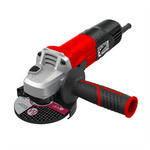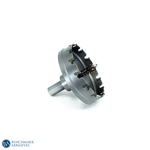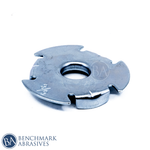
Coated Abrasives: Types, Components, and Uses

Coated abrasive is produced by bonding abrasive grains to a backing material or flexible substrate using adhesives. Paper, fabric, vulcanized fiber, and plastic films are widely used as backing materials.
What is Coated Abrasive?
A coated abrasive is an abrasive tool made up of a thin film of abrasive grain attached to a substrate such as paper, fabric, etc. Coated abrasives develop in various shapes such as sheets, discs, rolls, specialties, or belts.
“Coated abrasives are sometimes referred to as "sandpaper," but they are not made with sand and are not backed by paper.“
Applications of Coated Abrasive
In today’s markets, such as furniture, lumber, cabinet, boat, automobile, welding, foundry, jewelry, and do-it-yourself markets, coated abrasives are produced in "jumbo" rolls and then cut into various shapes, such as belts, discs, rolls, and sheets, for surface treatment and polishing applications.
Sanding rolls and sanding belts, typically for non-precision operation, are commonly coated abrasives for physical applications. These two styles are known as symbolic coated abrasives by the general public.
Other coated abrasives include sanding sheets, sanding discs, flap discs, flap wheels, cross pads, deburring wheels, and many more.
Components of Coated Abrasives
Let’s know each component of coated abrasive in detail. The popular abrasive grain structures are below:
- Ceramic
- Aluminum Oxide
- Zirconium
- Silicon Carbide
- Garnet
Types of Backings Used in Coated Abrasives
Below are the four significant types of backing materials:
Paper
For coated abrasives, highly technical papers are used as substrates. The letters reflecting weight and versatility define them: "A and "B" weights are lightweight and extremely flexible. "C,” "D,” "E,” "F" weights with more strength and less versatility are medium to heavyweight.
Cloth
Cloth backings are more reliable than paper backings. Cotton, polyester, and polyester-cotton combinations are significant types of cloth backings. Weight and versatility determine cloth backings. Cloth backing is ideal for applications of heavy-duty grinding and deburring. It provides excellent stability on the edge.
Fiber
A rigid vulcanized material made from rag stock is fiber backing. For abrasive fiber discs, this backing is commonly used. The mixture’s backing is laminated paper and fabric and is very solid and resistant to shock. For a wide variety of grits and mounting methods, combination backings are usually used.
Other Backing Materials
There is also a range of different substrates coated for particular uses, such as nylon fiber or screens. Another substrate that can be used for drying, polishing, or mixing is non-woven nylon impregnated with abrasive grains.
Types of Coated Abrasives

Here are some of the common types of coated abrasives available:
Cartridge rolls
Cartridge rolls are abrasive-coated rolls that are suitable for sanding and finishing spaces that are difficult to access. The cartridge rolls are used on inside surfaces and inside corners where other abrasives can not reach high-speed grinders.
Cartridge rolls have an aluminum oxide-coated material that can provide a versatile method of hand sanding, especially in metalwork.
Cross Pads
Cross pads are used for small channel polishing, end deburring, and workpiece finishing. The Cross Pads provide greater flexibility and make it easier for users to see through the contact region.
These cross pads are perfect for fast grinding on channels, corners, or spotting on flat surfaces.
Deburring Wheels
Deburring wheels are used to wash, blend, deburr, finish, and polish metals and glass. For light to heavy precision mixing, deburring, and washing, these deburring wheels are ideal.
Deburring wheels provide uniform finishing to components and quickly and easily deburr the workpiece compared to hand finishing.
Flap Discs
With a product that can grind and finish in one single action, flap discs offer precise angle grinding flexibility. Flap Disc is ideal for most ferrous & non-ferrous materials for sanding and finishing of welds, deburring, rust reduction, and snagging.
Flap Wheels
For most applications, from grinding to polishing, Flap Wheels are used. These flap wheels are usually used on ferrous alloy, high tensile materials, and a workpiece to finish complex shapes and tight contours.
The versatility of the wheel helps it navigate places that are hard to reach. On grinders, drills, impact wrenches, or handheld rotary tools, flap wheels connect.
Sanding Belts
Sanding Belts are used for deburring, grinding, blending, finishing, and polishing. These belts are back with cloth, paper, or film.
Surface Conditioning
Surface Conditioning Discs come in an all-inclusive range of grades and sizes and are an ideal first step for washing, mixing, deburring, and finishing.
Storage and Handling of Coated Abrasives
The performance of abrasives can be affected by improper storage of coated abrasives. Both types of backings are subject to temperature and humidity fluctuations during storage:
- Keep the storage area at steady humidity (35-50 percent) and temperature (60-80 °F) levels.
- Keep cartons away from damp or cold walls and floors where moisture can be absorbed.
- Store coated abrasives away from any source of heat.
- Fiber discs withdrawn from the original packaging should be placed in an appropriate disc holder and held under pressure.
- On shelves or pallets, shop bulk rolls flat, not on the side.
- Belts removed from the packing case should be rolled up and on a clean shelf standing on the edge. They can be drawn over a vast cylinder, but a belt can never be suspended from a nail or peg (the backing will crease, and the abrasive coat will crack)
- It is a precondition for optimum performance of the coated abrasive products in humidity and temperature-controlled settings before use.
Built to Cut, Designed to Last
Coated abrasives offer flexibility, precision, and power across industries—from heavy-duty grinding to fine finishing. With a range of backing materials and abrasive grains, these tools are tailored for everything from woodworking and metal fabrication to delicate polishing work. Their versatility in form—rolls, belts, discs, flaps, and more—means there’s a match for every surface challenge. When stored and handled properly, coated abrasives deliver consistent performance and longer tool life, job after job.



































































